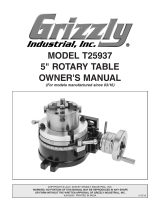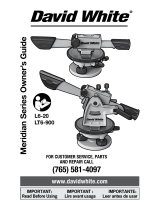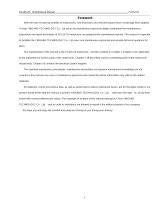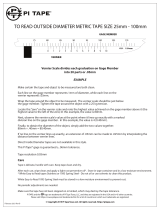
0
10 20 30 40 50 60 70 80 90
0
0.05mm
mm
Object to be measured is positioned between these surfaces.
Measures extremal dimensions. Slide vernier to open and close.
Measures the height of steps.
Measures internal dimensions. Slide vernier to open and close.
Position surfaces inside object to be measured.
Locks the vernier slide in place.
Indicates measured value in 1mm graduations.
Bar for measuring depth. Bar moves in and out with vernier slide.
Depth is measured between these two surfaces.
Position thumb on knob to move vernier slide with accurate control.
Scale for measuring with a resolution of 0.05mm.
Refer to following page for instructions on use.
Measuring Surface For Outside Measurements
Outside Jaws
Measuring surfaces for step measurements
Inside Jaws
Measuring surfaces for internal measurements
Lock Screw
Scale
Depth Bar
Measuring surfaces for depth measurements
Thumb Knob
Vernier Slide (Vernier Scale)
KAIDAN (Ziggurat) VERNIER CALIPERS
Precision Measurement Tools
GVC-15KDS
Model No.
User Manual
Thank you for purchasing the KAIDAN (Ziggurat) VERNIER CALIPERS.
This product is a precision measurement tool with a main scale and vernier scale graduations to indicate the measured value.
For safe and proper use of this product, please read this instruction manual before use and follow the procedures described.
Please keep manual where it is accessible to user for future reference.
Keep this manual with the instrument if transferred or leased to a third party.
For inquiries about this product, please contact dealer or Niigata Seiki at the address listed on the following page.
■Part Identification and Description
Read the instruction manual and follow the
instructions.
Use of product other than as described in the manual
may cause accident.
Use only for measuring.
Use for any purpose other than measuring may damage
or wear the instrument. Improper use may also cause
accident.
Handle with care.
Do not drop or subject instrument to excessive shock. Do
not place under heavy objects. Improper handling may
cause damage or poor accuracy.
Do not scratch instrument, for example by writing ID
number.
Use in proper environment.
Please do not use instrument in rain or locations with
excessive humidity. Do not use at extreme high or low
temperatures. Keep out of direct sunlight.
Jaw tips are sharp -- Handle with care.
Careless handling may cause injury.
When lock screw is tightened, do not attempt to
move the vernier slide.
Excessive force to vernier slide will cause damage or
cause poor accuracy.
Do not disassemble or modify.
Do not remove the vernier slide, Please do not attempt to
disassemble or modify as it may cause damage or poor
accuracy.
Measuring Surface
For Outside Measurements
Outside Jaws
Measuring surfaces for internal measurements
Lock Screw
Thumb Knob
Vernier Slide (Vernier Scale)
Scale Depth Bar
Inside Jaws
Measuring surfaces for
depth measurements
Measuring surfaces for
step measurements
Safety Precautions Please Observe
Always follow the proper operating procedures in order to prevent
harm to yourself or others, and to prevent damage to property.
Indicates risk of personal injury or property damage if not followed.
Caution
Denotes a PROHIBITION-
You MUST NOT do
Denotes a REQUIREMENT-
You MUST do

mm
mm
mm
0
10 20 30 40 50 60 70 80 90
0
0.05mm
0
10 20 30 40 50 60 70 80 90
0
0.05mm
0
10 20 30 40 50 60 70 80 90
0
0.05mm
0
10 20 30 40 50 60 70 80 90
0
0.05mm
PREPARATION FOR USE
Before using the caliper, please perform the following:
●Loosen the lock screw.
Moving the vernier slide with the lock screw tightened may cause unnecessary force to the slide which will damage the caliper and
affect accuracy.
●Wipe off any corrosion, dirt or oil from measuring surfaces and slide.
Contamination of surfaces may cause measurement error.
●Allow the caliper and object to be measured time to reach the same temperature.
A temperature difference between the object to be measured and the caliper may cause measurement error. Allow enough time for the
temperatures to equilibrate.
●How to perform accuracy check.
①Jaw Alignment
In closed position, make sure the measuring surfaces on the outside
jaws align properly and there is no gap (no light should leak past.)
②Confirm “0” points on scale (ref. diagram at right)
With jaws closed as in step ① above, make sure the reading is zero and
the verier scale graduations align at the “0” and “39” positions as shown.
③Depth Confirmation
Position caliper on a flat surface for depth measurement. Reading should
be “0” as in step ② above, with the verier graduations aligned at the “0”
and “39” positions.
READING THE SCALE
The measured value is determined by reading the main scale,
and then adding the vernier scale reading as determined by the
position where the vernier and main scale graduations align.
PREVENTING ERRORS
In order to prevent measurement error, please note the following.
AFTER USE CARE, STORAGE NOTES
1411I223-K
●Material : Stainless Steel
●Measuring Range : 0 150 mm
●Resolution : 0.05 mm
●Accuracy : ± 0.05 mm
PRODUCT SPECIFICATIONS
●As required, wipe slide and measuring surfaces with a dry
cloth treated with anti-corrosive oil.
When not in use, apply anti-corrosive treatment or keep in
anti-corrosive bag.
●When not in use, keep jaws slightly open and lock screw
slightly loose to prevent over tightening due to thermal
expansion which may affect accuracy.
●Store in supplied case when not in use in a cool, dry location.
●Wear of measuring surfaces from repeated use may affect
accuracy. We recommend that instrument accuracy is
confirmed through calibration on a periodic cycle.
●EXAMPLE 1
Measured value = Main Scale Reading + Vernier Scale Reading
77
0.00+
77.00
Reading
77
0.30+
77.30
Reading
77
0.35+
77.35
Reading
Measured Value: 77.00mm
Measured Value: 77.30mm
Measured Value: 77.35mm
Main Scale
(1mm)
Vernier Scale
(0.05mm)
Main Scale
(1mm)
Vernier Scale
(0.05mm)
Main Scale
(1mm)
Vernier Scale
(0.05mm)
●EXAMPLE 2
●EXAMPLE 3
HOW TO POSITION CALIPER ON OBJECT FOR MEASUREMENT
VIEWING THE SCALE
Proper alignment
Object being measured
Jaw
Niigata seiki Co., Ltd.
6-15-22, Tsukanome, Sanjo, Niigata, Japan, 955-0055
Tel. : +81-256-31-5660 Fax. : +81-256-39-7730
MAIL [email protected]
URL
http://www.niigataseiki.co.jp
Flat surfaces --
When measuring features
with flat surfaces, make
sure the measuring surface
of the jaws are parallel to the
surfaces to be measured.
Cylindrical surfaces --
When measuring cylindrical
features, make sure the
caliper jaws are
perpendicular to the cylinder
axis as shown.
Scale should be read from
directly above the calipers.
Due to step in height of
vernier scale relative to
main scale, if viewing
direction is not directly
above the reading may have
parallax error.
-
 1
1
-
 2
2
Ask a question and I''ll find the answer in the document
Finding information in a document is now easier with AI
Related papers
-
Niigata seiki VERNIER CALIPERS User manual
-
Niigata seiki VERNIER CALIPERS User manual
-
Niigata seiki GHB-** User manual
-
Niigata seiki GVG-1 User manual
-
Niigata seiki JLVC-30 User manual
-
Niigata seiki C3030C User manual
-
Niigata seiki GDCP-150 User manual
-
Niigata seiki GDCS-150IR User manual
-
Niigata seiki GDCP-200AA User manual
-
Niigata seiki SB-NM1025 User manual
Other documents
-
LittleMachineShop 2983 User manual
-
 Grizzly Industrial T25937 Owner's manual
Grizzly Industrial T25937 Owner's manual
-
 David White LT6-900 Owner's manual
David White LT6-900 Owner's manual
-
Grizzly H7506 Owner's manual
-
HP 809C User manual
-
 Yingang YG125-25 Maintenance Manual
Yingang YG125-25 Maintenance Manual
-
Nikon Microscope & Magnifier SMZ-10 User manual
-
 Pi Tape O.D. METRIC for Tape Size 25mm - 100mm Operating instructions
Pi Tape O.D. METRIC for Tape Size 25mm - 100mm Operating instructions
-
Kaidan Meridian TM-400 User manual
-
HP 8505A User manual





